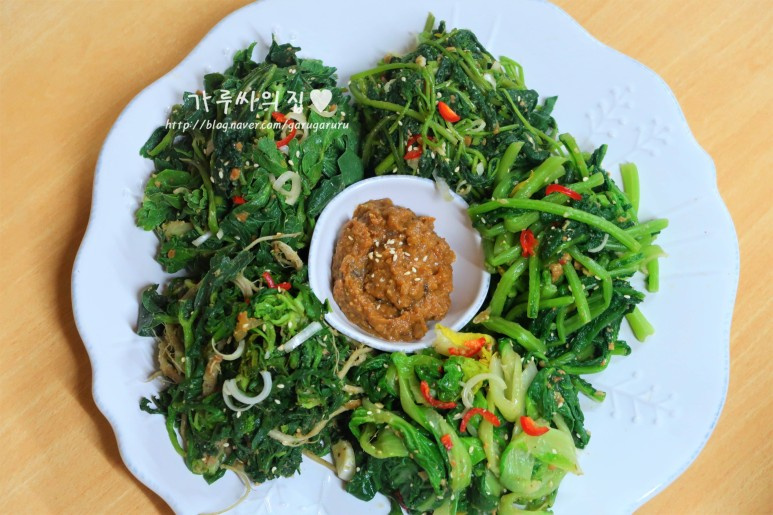Five Spring Greens Seasoned with Doenjang
Enjoy a Delicious Doenjang-Seasoned Salad with 5 Spring Greens: Nasturtium, Spring Cabbage, Young Radish Greens, Korean Angelica Tree, and Mugwort

Spring brings an abundance of fresh, vibrant greens! Learn how to easily and deliciously season them with our versatile Doenjang (Korean fermented soybean paste) sauce. Brighten up your dining table with the beautiful green hues of spring! ♬
Main Ingredients- Prepared young radish greens (Yeolmu)
- Spring cabbage (Bomdong)
- Korean Angelica tree leaves (Bangpum)
- Mugwort (Chwinamul)
- Nasturtium (Naengyi) 200g
- Red chili pepper
- Crushed sesame seeds
- White green onion, a little
- Sesame oil, a little
Versatile Doenjang Sauce- Doenjang 180g
- Rice water 50ml
- Onion 1/4
- Minced garlic 1.5 Tbsp
- Perilla oil 1/2 Tbsp
- Doenjang 180g
- Rice water 50ml
- Onion 1/4
- Minced garlic 1.5 Tbsp
- Perilla oil 1/2 Tbsp
Cooking Instructions
Step 1
For detailed recipe instructions, please refer to the video: https://youtu.be/GWglVNGdvLs

Step 2
First, trim the tough root ends off the young radish greens (Yeolmu) with a knife and discard them.

Step 3
Clean the nasturtium (Naengyi) by removing its fine roots and any dirt clinging between the roots and leaves. Then, cut them into bite-sized pieces. This preparation is key!

Step 4
Remember to cut out the tough core from the spring cabbage (Bomdong) before chopping it. This ensures a tender texture.

Step 5
For the Korean Angelica tree leaves (Bangpum), feel the stems. If they feel tough or woody, remove and discard those parts.

Step 6
Mugwort (Chwinamul) generally doesn’t require extensive preparation. Just pick out and discard any bruised or wilted leaves for the best quality.

Step 7
Blanch the greens in boiling water with 1/2 Tbsp salt: Nasturtium for 2-3 minutes, Korean Angelica tree leaves for 2 minutes 30 seconds, Spring cabbage for 3 minutes 30 seconds, and Mugwort for 4-5 minutes over high heat. Blanching time is crucial for each type of green.

Step 8
Young radish greens (Yeolmu) are an exception. Blanch the stems first for 1 minute, then add the leaves and blanch everything for about 3 minutes 30 seconds.

Step 9
Immediately after blanching, rinse the greens twice in cold water. Drain them thoroughly in a colander and gently squeeze out any excess water with your hands.

Step 10
For the final prep, if the young radish greens are long, cut them into 3-4 segments. For larger spring cabbage leaves, tear them by hand into more manageable pieces.

Step 11
Finely mince the onion to help it blend seamlessly into the sauce. Thinly slice the red chili pepper and white green onion for garnishing.

Step 12
Heat a ttukbaegi (earthenware pot) over medium to medium-low heat. Add perilla oil and sauté the minced onion until translucent, about 2 minutes.

Step 13
Once the onion is slightly softened, add the doenjang and minced garlic, stirring to release their aromas.

Step 14
Pour in the rice water and bring to a simmer. Don’t add all the rice water at once; gradually add it in portions while stirring and simmering, until you reach your desired sauce consistency. This should take about 4-5 minutes.

Step 15
Keep in mind that the doenjang sauce will thicken as it cools. Adjust the simmering time accordingly to achieve the perfect consistency when serving.

Step 16
Gently loosen the squeezed greens. Add the prepared doenjang sauce and mix well, tossing until the greens are evenly coated.

Step 17
Finally, add the sliced red chili pepper, white green onion, crushed sesame seeds, and a drizzle of sesame oil. Toss gently to combine. Your delicious spring greens salad is ready!

Step 18
For a flavor variation, consider adding a touch of gochujang (Korean chili paste) or gochugaru (chili flakes) for a spicy kick, or a little maesilcheong (plum extract) for sweetness. These additions can create a wonderfully unique taste.

Step 19
This doenjang sauce is not intended for long-term storage. If you have any leftover sauce, it’s perfect for serving with boiled pork (suyuk) or adding to doenjang jjigae (soybean paste stew) for an extra layer of flavor. It’s a great way to minimize waste!



